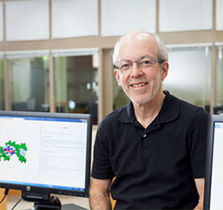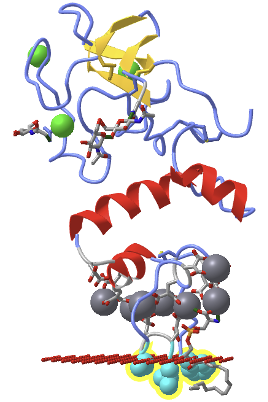Education Corner
Fundamentals of Biochemistry: A new online biochemistry textbook with interactive molecular and mathematical modeling
By Henry Jakubowski, Ph.D., Professor Emeritus, College of St. Benedict/St. John’s University

Henry Jakubowski is an Emeritus Professor of Chemistry at the College of St. Benedict/St. John’s University (MN), where he taught chemistry, biochemistry, history of science/medicine and biomedical ethics courses over a 32-year career. He is presently retired and living in Brooklyn, NY where he and his wife help take care of grandchildren. He also is an active member of BioMolViz, which promotes biomolecular visualization literacy, and Molecular CaseNet, which promotes the development and use of molecular case Studies at the interface of biology and che mistry.
I’d like to describe a new free online biochemistry text, Fundamentals of Biochemistry, part of the LibreText initiative to provide free online textbooks for all chemistry courses in the undergraduate curriculum. This text covers a full-year sequence of biochemistry and is available now (although without embedded problems and chapter learning goals/summaries).
The book could serve traditional, American Chemical Society-certified, and American Society for Biochemistry and Molecular Biology-certified majors, as well as students taking a one-semester course. Adopting instructors could create a custom text from the content. Patricia Flatt and I are the main authors/compilers of the text, which contains much content freely available through Creative Commons licenses. Visit the preface of the book for more information on our philosophy in writing the book. The book contains many interactive features for both molecular visualizations and for mathematical analyses as described below.
Molecular modeling using iCn3D:

iCn3D visualization of prothrombin fragment 1 from PDB structure1NL2
I have embedded almost 500 different interactive PDB structures directly in the book, using iCn3D as the molecular visualization tool. Users can display molecular models that have been rendered to illustrate specific features of the structural and functional properties of biomolecules. Users can alter a rendering and obtain a new web link for their model, which could be emailed to instructors for assessment.
The type of pre-displayed rendering is context- and learning goal-specific. A model for protein structure might emphasize a cartoon colored by secondary structure (an example), while one for catalysis might show catalytic and binding groups in an active or allosteric site, with the overall protein grayed out (an example). A catalytic mechanism using curved arrows supports these structural models. A section on conformational change or structural similarities would show two alternative structures, toggling (using the “a” key) between each (an example). Most membrane proteins can be displayed with dummy atoms representing each monolayer of the membrane, as shown in the illustration for prothrombin fragment 1.
I chose to use iCn3D for its ease in making the images (using a GUI with no coding or commands required) and ease in embedding models into the text. In addition, iCn3D can display AlphaFold and molecular modeling database (MMDB) files, which are effectively PDB files enhanced with database information including sequence, interaction and alignment information.
Mathematical Modeling
A fuller understanding of the complexity of biochemical interactions and functions requires mathematical analyses. This is especially true in the study of binding, catalysis, and metabolic/signaling pathways. I’ve incorporated two interactive components to facilitate a mathematical understanding of simple binding to complex signaling interactions:
Interactive mathematical graphs:
Experienced Instructors know that students struggle to interpret equations and graphs. For example, obtaining and interpreting key constants from the straight-line Lineweaver-Burk plot is much more challenging for them than graphical analysis of the simpler equation y=mx+b. I’ve included many interactive live graphs for which users can change constants and see immediate graphical updates. Here is a link to a graph that shows progress curves (concentration vs time) for the reversible reaction of A ↔ B, designed to help students also understand the relationships between rate and equilibrium constants.
Computational Modeling Using VCell:

Reaction diagram showing the activation of mitogen activated protein kinase (MAPK) by the three-enzyme cascade starting with mitogen activated protein kinase kinase kinase (MKKK).
Most biochemistry texts emphasize the initial rate Michaelis-Menten kinetic plots for irreversible catalysis. Progress curves are typically limited to show that enzyme-substrate complex ES becomes constant under the steady-state conditions. Yet progress curves are more intuitive and are also used to calculate initial rates. I’ve added a series of Vcell models that show progress curves for individual reactions to a series of nested reactions from signaling pathways. Users can run simulations for included models quickly within the text and get output graphs and spreadsheets showing the concentration of all species with time. For example, the reaction diagram below shows the activation of mitogen-activated protein kinase (MAPK) by the three-enzyme cascade starting with mitogen-activated protein kinase kinase kinase (MKKK).
You can run the simulation (select OMEX) yourself to see the progress curves for the reaction when the doubly-phosphorylated MAPK (MAPK_PP) end product phosphorylates and inhibits the first kinase (MKKK) in the cascade. (Note: Errors in scaling will be corrected in the soon-to-be-released next version of Vcell.)
I added Part IV - Special Topics, which extends coverage to material not found in biochemistry texts. Presently, I’m writing Chapter 31: Biochemistry and Climate Change, and hope to have it mostly completed for a ASBMB Interest Group on the topic in the March 2023 Seattle meeting.
We are actively seeking people who would like to write chapter summaries, learning goals, end-of-chapter problems, and supplementary content such as Quantum Biochemistry. If you are interested, contact Henry Jakubowski (hjakubowski@csbsju.edu).